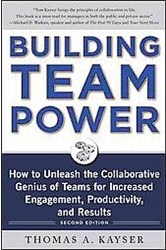Recommended Resource – Building Team Power
Building Team Power: How to Unleash the Collaborative Genius of Teams for Increased Engagement, Productivity, and Results
by Thomas Kayser
About the Book
Building Team Power by Thomas Kayser examines the structural mechanisms and behavioral traits that combined to create highly collaborative teams. Thomas provides practical, detailed methods for leaders at every level of the organization to foster and enhance the collaboration between team members in six critical areas:
- Mutual Trust
- Decision-Making
- Consensus Building
- Conflict Management
- Delegation Effectiveness
- Team Problem Solving (two scenarios)
Benefits of Using this Book
StrategyDriven Contributors like Building Team Power for its immediately actionable insights into enhancing team collaboration at any level within an organization. We found Thomas’s methods to be deeply insightful, originating from sound academic principle and refined with real world experience during his thirty years at Xerox. Building Team Power is highly prescriptive, complete with process flows and charts that convey to the reader how to implement the team building methods.
If we had one critisism of Building Team Power, it would be that the procedure-like formatting of the methods provided would be impractical to implement in a team setting. That said, we believe the book would make an excellent tool to create management training courses and teamwork checklists and guides.
Building Team Power embodies many of the principles StrategyDriven recommends in building highly aligned and accountable organizations. Additionally, it mirrors many of our decision-making best practices. For these reasons, its academic foundation and real world refinement, and its implementability, Building Team Power is a StrategyDriven recommended read.


 Projects represent change and change requires communication. In order for communication to be successful, it must be received, understood, and acted upon. Achieving these factors can require a substantially different approach when communicating with different groups and individuals. Consequently, effective communication is frequently difficult and time consuming. Thus, a clearly defined communications plan is needed to maximize the probability of each communication’s success while minimizing the overall effort expended.
Projects represent change and change requires communication. In order for communication to be successful, it must be received, understood, and acted upon. Achieving these factors can require a substantially different approach when communicating with different groups and individuals. Consequently, effective communication is frequently difficult and time consuming. Thus, a clearly defined communications plan is needed to maximize the probability of each communication’s success while minimizing the overall effort expended. Projects, like other business activities, involve meetings and approvals. The difference between project and routine business meetings is that a project is not an ongoing concern; therefore, its meetings tend to be periodic, sporadic, or driven by one-time needs rather than recurring with some regular frequency. Consequently, these off-routine meetings and approval review sessions are a disruption to non-project team executives, managers, and contributors; representing something these individuals naturally resist so to protect the time for their normally scheduled duties.
Projects, like other business activities, involve meetings and approvals. The difference between project and routine business meetings is that a project is not an ongoing concern; therefore, its meetings tend to be periodic, sporadic, or driven by one-time needs rather than recurring with some regular frequency. Consequently, these off-routine meetings and approval review sessions are a disruption to non-project team executives, managers, and contributors; representing something these individuals naturally resist so to protect the time for their normally scheduled duties. Think about if there were no guardrails on the freeway. It would be all too easy to run off the road and find yourself hurt and way off the fast track to your end destination.
Think about if there were no guardrails on the freeway. It would be all too easy to run off the road and find yourself hurt and way off the fast track to your end destination. Rich Christiansen describes himself as ‘a perfectly good business executive, turned entrepreneur.’ Before becoming an entrepreneur, he was a skilled executive and market innovator in the corporate world. He was General Manager at both Mitsubishi Electric and About.com. After 20 years in the technology industry, he discovered that his true passion and talent is in launching start-up companies.
Rich Christiansen describes himself as ‘a perfectly good business executive, turned entrepreneur.’ Before becoming an entrepreneur, he was a skilled executive and market innovator in the corporate world. He was General Manager at both Mitsubishi Electric and About.com. After 20 years in the technology industry, he discovered that his true passion and talent is in launching start-up companies.